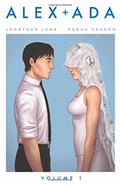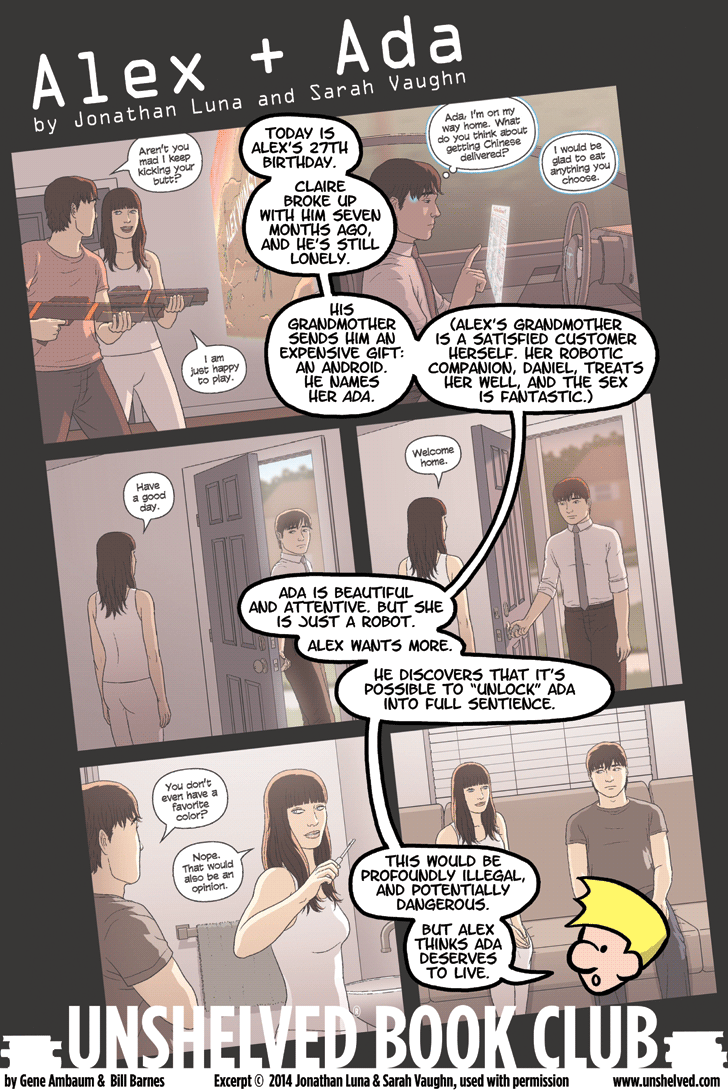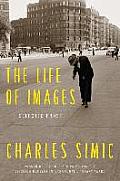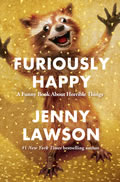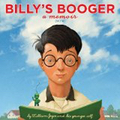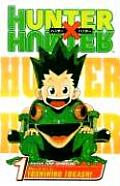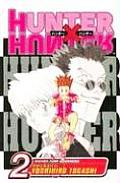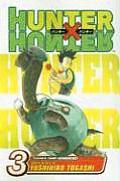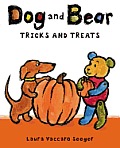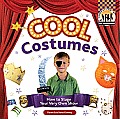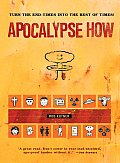Link to this review in the form of a comic strip by billba tagged graphic novel • romance • science fiction
Link to this review by wally tagged poetry • essays • nonfiction
This volume gathers forty-one essays by the 2007 Poet Laureate Charles Simic, the best of his previously published writing and a few uncollected essays. Simic writes naturally about poetry and poets, philosophy and philosophers, and also about his youth as a new American, the fall of the Soviet empire, and the breakup of his native Yugoslavia. Throughout he demonstrates a down-to-earth intelligence and humor.
Why I picked it up: Simic is one of my favorite poets. His poems are short and often play with some unusual and striking image, whether from his childhood in war-torn Yugoslavia or a photograph.
Why I finished it: Simic tells a great story. In “The Singing Simics,” which talks about various family members of his who all liked to sing, he begins by describing how he broke a blood vessel in his mouth when he sang a Mozart aria for fun, then tells how his uncle Boris would sing along at the opera, driving everyone nuts (especially the tenor). And he often gave me a new appreciation for an artist’s work. In a longer piece called “Buster Keaton,” he examines Keaton’s comic timing in a number of his films, such as when Keaton draws a chalk hook on a wall and then hangs his coat on it. He concludes by saying that Keaton should be the favorite philosopher of anyone who seeks true seriousness.
It’s perfect for: Daniel, who would appreciate the various essays on writing poetry. In one Simic talks about how he lets the poem take over when he’s writing it, and says, “I wanted to go to church but the poem took me to the dog races.”
Link to this review by dawnrutherford tagged essays • nonfiction
Jenny Lawson, better known to her many many internet fans as The Bloggess, lives her life in an emotional turmoil of constant change. She has more psychiatric disorders (including anxiety, depression, OCD, and ADD) than most people have hats, yet remains happily married to a very patient man and has a “surprisingly well adjusted” daughter. In this collection of essays she shares some of her personal triumphs and most humiliating moments (they are often the same), plus her advice on how to live shamelessly with mental illness.
Why I picked it up: I really loved her first book, Let’s Pretend This Never Happened, for its bizarre, true-life stories about her family, friends, and personal disasters. Plus the maniacal, gleeful-looking taxidermic raccoon on the cover beckoned to me from within its cloud of glittery confetti.
Why I finished it: When I picked this up I was really just expecting a collection of stories from Lawson’s blog, and was a bit disappointed it didn’t have my favorite, “It Doesn’t Take Much to Make Me Happy.” (It’s about the time she bought a giant faux bear head at a furniture store and then terrorized her husband, cats, and neighbors with it.) But there are other laugh-out-loud stories, like the one about the time she dressed up in a koala suit and tried to convince Australian zoo keepers to let her hold a live koala. But the real meat of this book is her well-articulated thoughts on how we need to normalize mental illness if we really want to help those suffering from it to lead bearable lives. One of the best essays talks about how we never shame cancer patients or try to convince them to stop getting treatment if one medicine doesn’t work, but we do this all the time to those suffering from depression or anxiety. She shows that if people are going to get help and the medical care they need, society needs to take away all the social stigma from trying to get that help.
It’s perfect for: My friend X who bravely started a closed Facebook group when he went off his meds in order to establish a baseline for his mental illness with support from his friends. He ended up creating a wonderful community of folks who now have a safe place to get support through rough times from like-minded people. Together we are all learning the value of being open and honest about what we are going through, and how amazing it is to have people we can be our true selves with. (Jenny does much the same thing with her followers in the comments section on The Bloggess.)
Link to this review by dawnrutherford tagged audiobook • nonfiction
At sixty-six years of age, legendary cult movie director John Waters went looking for adventure. He had gotten into a comfortable rut with his cozy home and solid career. He already hung out in biker bars regularly and was over experimenting with drugs, but he wanted to get back to his roots and do something daring and unexpected. So he decided to hitchhike across America, starting on the street of his Baltimore home and ending at his apartment in San Francisco. Would people recognize him everywhere he went? Or worst yet, would they not?
Why I picked it up: I have a great fondness for John Waters and his movies because of his love of weirdos of all shapes and types. I admire his sincerity, passion, and how comfortably odd he is, and wanted to see what happened when he took it on the road. Plus he reads the audiobook himself, and I like the idea of him talking to me during my daily commute.
Why I finished it: The book surprised me in fun ways. Waters quickly realized that it was pretty unlikely that any hitchhiking road trip would live up to his imagination, so the first two thirds is made up of the best- and worst-case scenarios from the darkest reaches of his brain. This being John Waters, these two are sometimes indistinguishable: hipster carnival rave in the middle of nowhere, secret trucker pickup bar, obsessed fans who know all his lines…and use nothing else to talk. Over the top animal rescuers, drug dealers, and perverts appear throughout, imagined as though they’ve all just wandered out of one of his movies. The last third of the book is the actual journey itself, and does turn out to be much more mundane. Everyone who picks him up is quite decent if not overwhelmingly kind. He bonds with an indie rock band, takes calls from amazed fans who happen to be relatives of some of his drivers, and discovers just how awful and lonely chain restaurants in middle America can be. The worst part of the whole trip is the mind-numbing boredom that comes with waiting for a ride, which sometimes takes hours if not a whole day despite his “I’M NOT PSYCHO” sign.
Readalikes: The soundtrack, which Waters admits he had friends help him out with, was perfect. It’s a fine mix of campy and bizarre road songs, mostly from the 50s, that he hears on car radios throughout the fictional sections of the book, and which always drive home the tone of the moment with excess. I was a little disappointed not to get to hear the songs as part of the audiobook, but the internet provides: here is the playlist a reader constructed of YouTube videos. It reminded me of other books I’ve read where music is such an important part of the author’s life, especially Rob Sheffield’s memoirs in which he records memories triggered by favorite songs from different periods of his life. The first one, Love Is a Mix Tape: Life and Loss, One Song at a Time is my favorite — it’s a heartbreaking description of falling in love with his wife and becoming a widower much too soon after their wedding.
Link to this review by geneambaum tagged humor • biography • graphic novel
Billy loves monster movies and comics. He has an active imagination and tries to make everything more fun, including school. His teachers aren’t sure what to do with his creativity. A contest at school to make the best kids’ book ignites his brain, and he spends a few days writing and drawing his book, Billy’s Booger.
Why I picked it up: It had the word “booger” in the title. Then my daughter reminded me that he wrote The Man in the Moon and the other Guardians of Childhood books.
Why I finished it: Hidden in the middle of the book is a reproduction of the book Joyce wrote and drew as a child, about a superpowered booger knocked out of a kid’s nose when he’s hit by a meteorite. It’s insane in the way only a picture book drawn by a fourth grader can be, and it still looks better than anything I can draw now.
Readalikes: It immediately reminded me of Battle Bunny by Scieszka, Barnett, and Myers, a book which was called Birthday Bunny until the young boy who got it as a present crossed out all of the boring parts, rewrote it, and changed the pictures to make it more entertaining.
Link to this review by geneambaum tagged coming of age • graphic novel
Gon will not be stopped. He wants to become a Hunter like his father, Ging, one of those who track down hard-to-find items and people. Then he’ll track down his dad. But first Gon has to get a Hunter’s license. The rigorous exam is often deadly for those who take part, and Gon is quite young compared to the other applicants. Despite the odds stacked against him, he never stops smiling.
Publisher’s Rating: Rated T+ for Older Teen
Why I picked it up: I was bemoaning the fact that Naruto is over. Viz’s Mark de Vera told me that Gon has the same drive and determination as Naruto.
Why I finished it: Gon is not only naturally perceptive (he’s the only one who can tell the difference between shapeshifters who look the same to everyone else), he’s also extraordinarily good-natured. In a field of candidates that includes at least one murderer and another out to sabotage the exam for as many others as possible, it was impossible not to root for him.
Readalikes: The third phase of the Hunter exam involves one-on-one fights in which Gon and four others take on five terrifying prisoners fighting for reduced sentences. They’re alternately brutal and funny. The only other fighting tournament I’ve read recently that was this entertaining was in the first two volume of The Last Man, a manga-inspired French graphic novel full of magic and fisticuffs.
Link to this review by robert tagged picture book
Colorful illustrations show the action in this collection of three Halloween stories featuring Dog and Bear. It leads with a story about getting and trying on costumes, and ends with one about wearing them.
Why I picked it up: I’d been looking for a fun, not-at-all-scary Halloween book for some of my youngest relatives.
Why I finished it: It’s full of great humor. In particular, the middle of the three stories, “Ding Dong,” features the sort of laughable confusion about who gets the treats for “trick or treat” that would appeal to Marx Brothers fans.
It’s perfect for: My coworker Jennifer’s children. The bold blocks of color and thick lines in the illustrations are reminiscent of the bright work those kids do with crayons and watercolors.
Readalikes: For those who want to see more realistic animals celebrating Halloween, try Carl’s Halloween by Alexandra Day.
Link to this review by robert tagged picture book • nonfiction
If you and your trick-or-treating friends and relatives would like some great tips on making costumes, this is a great starting place. The book is intended for juvenile stage actors and young costume makers. That means it’s full of inexpensive and easy-to-make ideas that include using tulle fabric strips and ribbon to make a ballet dancer’s skirt and half a bed sheet to make a cape. For those who want to create creatures, Kenney shows how elastic and pipe cleaners can be turned into animal ears.
Why I picked it up: I’d once spent hours (with my mother’s help) making a hat, a cape, and a tunic for a renaissance fair. Aside from clothing repair, that’s the most ambitious I’ve been with fabric crafts. I wanted to see if there were quicker and easier ways to disguise a modern office worker as a rustic peasant.
Why I finished it: The focus on costume elements instead of characters gives creators freedom to create a truly original costume. For example it shows how to make capes and paint t-shirts into skeletons, not how to look like Hamlet.
I know from my own trick-or-treating experiences that running around for a few hours is harder on costumes than most stage roles for children. If you’re using ideas from Cool Costumes for Halloween, consider robust materials and construction techniques that will hold up to a few hours of outdoor activity and the weather.
It’s perfect for: My coworker Caitlin, who roamed the halls of Comic-Con this year with needle, thread, pins, and a hot glue gun to render on-the-spot assistance to folks with wardrobe malfunctions. And my parents, who might want to switch from dressing the dog in a San Jose Giants t-shirt to putting him in a ballet skirt this Halloween.
Link to this review by sarahhunt tagged humor • nonfiction
A hilarious approach to surviving and enjoying yourself after the apocalypse, whether it is after The Rapture, nuclear war, or rule by human-hating robots. It’s full of helpful tips on what to wear, what to eat, and how to stay optimistic scavenging in a blasted wasteland.
Why I picked it up: A friend suggested it while I was reading yet another guide on how to prepare for disasters.
Why I finished it: Helpful, laugh-out-loud tips like a recipe for Steve Tartare (his name isn’t Steve? Well it is now!), how to distinguish useful information from annoying nostalgia in the stories of seniors (do their memories of the Model-T contain useful tips on the workings of a combustion engine?), and the fitness benefits of fleeing from our ape overlords.
I’d give it to: Dave, who jokes about stockpiling gold for the future economic collapse. He could use the tips on looking at the bright side of the Apocalypse: the chance to reinvent himself and finally do all of those things he’s been putting off!
